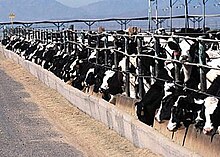Agricultural wastewater
Main article: Agricultural wastewater treatment
Riparian buffer lining a creek in Iowa
Sediment (loose soil) washed off fields is the largest source of agricultural pollution in the United States.[10] Farmers may utilize erosion controls to reduce runoff flows and retain soil on their fields. Common techniques include contour plowing, crop mulching, crop rotation, planting perennial crops and installing riparian buffers.p. 4-95–4-96
Nutrients (nitrogen and phosphorus) are typically applied to farmland as commercial fertilizer; animal manure; or spraying of municipal or industrial wastewater (effluent) or sludge. Nutrients may also enter runoff from crop residues, irrigation water, wildlife, and atmospheric deposition.[27]:p. 2-9 Farmers can develop and implement nutrient management plans to reduce excess application of nutrients:pp. 4-37–4-38
 To minimize pesticide impacts, farmers may use Integrated Pest Management (IPM) techniques (which can include biological pest control) to maintain control over pests, reduce reliance on chemical pesticides, and protect water quality.[28]
To minimize pesticide impacts, farmers may use Integrated Pest Management (IPM) techniques (which can include biological pest control) to maintain control over pests, reduce reliance on chemical pesticides, and protect water quality.[28] Confined Animal Feeding Operation in the United States
Farms with large livestock and poultry operations, such as factory farms, are called concentrated animal feeding operations or confined animal feeding operations in the U.S. and are being subject to increasing government regulation.Animal slurries are usually treated by containment in lagoons before disposal by spray or trickle application to grassland. Constructed wetlands are sometimes used to facilitate treatment of animal wastes, as are anaerobic lagoons. Some animal slurries are treated by mixing with straw and composted at high temperature to produce a bacteriologically sterile and friable manure for soil improvement.

No comments:
Post a Comment